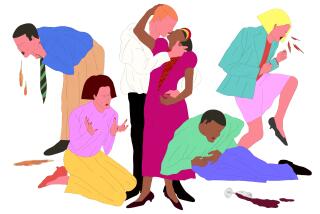Hospital’s Prescription: a Big Dose of Laughter
- Share via
“I sound silly,” said Ray Bolger, demonstrating an infectious giggle, one of the several laughs he uses to promote hilarity at Saint John’s Hospital and Health Center. “But that’s all right. I bet I made you smile.”
Bolger, perhaps best known for his film role as Scarecrow in “The Wizard of Oz,” is featured along with the Marx Brothers, Peter Sellers and other comedy greats on a “laughter channel” aired daily on television throughout the Santa Monica hospital.
“I talk about laughter and what it actually does to your insides,” said the 79-year-old actor, a former patient at the facility.
“In the first place, we lie there and we’re not stimulated. When we start to laugh, the red corpuscles start fighting with the white corpuscles . . . you can feel your chest move up and down . . . you exercise your stomach muscles. There’s a lot of therapeutic value to it.”
Introduces Segments
Bolger’s role is to introduce each segment of the nine hours of shorts and full-length movies that run from 3 p.m. until just before midnight.
Although the order changes on alternate days, the programming remains unchanged for six weeks at a time.
“What they have on, some of it is good, but it’s too repetitious,” said Al Houston, a patient who has been in Saint John’s for a week. “It’s a beautiful idea, though, because there’s nothing like laughter to heal. It makes you forget your problems.”
The broadcast includes a brief talk by Norman Cousins, whose writings have promoted the idea that laughter is good medicine.
“We’ve been able to establish that it does enhance respiration and helps oxygenate the body,” Cousins said in an interview.
The author, an adjunct professor at UCLA’s School of Medicine, said laughter can also counteract panic, a symptom that physically constricts blood vessels.
This makes it easier for the body’s healing process to get under way, he said, adding that although laughter is “a valuable adjunct to regular treatment, it should never be regarded as a substitute to competent medical attention.”
The program, which began in August, took about two years to develop, said Dr. Richard L. Taw, acting director of the cardiovascular department at the hospital.
Normally, he said, the main diet of early evening television is hour after hour of depressing news shows. The new programming offers an alternative with apparent therapeutic benefits.
“There may not be all that much solid scientific evidence to back that up, but . . . for our patients who have a temporary depression about an illness, this certainly can turn them around quicker and get them helping themselves,” Taw said.
Cousins said the channel also will help the hospital by keeping patients away from their nurse call buttons.
“In an atmosphere of solitude and idleness, people concentrate on their pains and want attention to be paid to their pains,” he said. “It is, I would say, a salubrious distraction.”
Although a recent study found no connection between attitude and survival rate among cancer patients, Taw said “practical experience and common sense” suggest good spirits can make a difference in some cases.
However, he said, “I don’t think that this will help everyone.”
Research Project
He said he hopes to set up a research project next year to see if watching comedy programs actually influences recovery rates in specific illnesses.
The doctor claims to have seen every Laurel and Hardy movie at least three times and every Abbott and Costello film at least once.
More to Read
The complete guide to home viewing
Get Screen Gab for everything about the TV shows and streaming movies everyone’s talking about.
You may occasionally receive promotional content from the Los Angeles Times.






